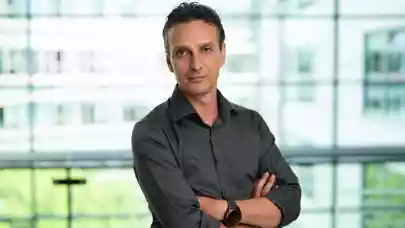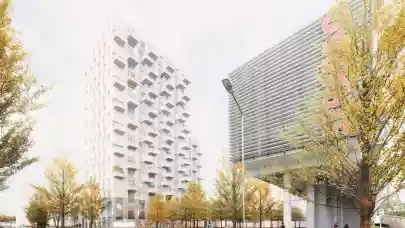
Andrei Radu, Group Development Director at NEPI Rockcastle, talked about the developer’s focus on net zero with a €100 million investment in clean energy production. With the recent launch of a 54 MW solar park in Romania, the group expects to cover almost 50% of its total CEE electricity needs by 2026, offering cost control and doing the "heavy lifting" for tenants.
Could you elaborate on the long-term vision behind NEPI Rockcastle’s €100 million investment programme in green energy, particularly the decision to pursue large-scale greenfield PV developments alongside rooftop installations?
The long-term vision behind NEPI Rockcastle’s €100 million renewable energy investment programme is to achieve net zero emissions across our portfolio, in full alignment with the EU Green Deal and the company’s broader ESG strategy.
Our aim is not only to reduce the carbon footprint of our operations but also to create a resilient and sustainable energy infrastructure that supports long-term value creation for our stakeholders.
The decision to pursue large-scale greenfield photovoltaic (PV) developments in parallel with rooftop installations reflects both an environmental and a strategic business rationale, for which we have a three-phase plan.
Rooftop systems are an essential first step, directly supplying our shopping centres with clean electricity while optimising existing assets across our portfolio, an initiative that began in 2022. However, greenfield PV plants, part of the third stage of the programme already developed in Romania, allow us to accelerate the decarbonisation process by generating significantly higher energy volumes through economies of scale, shorter construction timelines, and lower per-unit production costs.
What is NEPI Rockcastle’s projected timeline for reaching 45% of the group’s total electricity consumption from green sources?
The completion of the recently inaugurated Chișineu-Criș photovoltaic power plant, the largest supplying commercial infrastructure in Romania, followed by the second PV plant developed in two phases in Prahova County, will mean we are covering 45% of our Romanian electricity consumption by 2026. By then, we will have 159 MW of solar power installed capacity, which is the equivalent of almost 50% of the NEPI Rockcastle Group’s total electricity needs across the CEE portfolio.
What are the primary commercial and sustainability benefits NEPI Rockcastle anticipates from this high degree of self-supply?
We decided to invest in our internally generated power programme in 2022, at the height of the energy crisis when electricity prices soared, because it made sense from a cost perspective for us and our tenants. We already procure over 80% of our electricity from external renewable sources, but self-generated power gives us greater control over costs. The climate benefits of being able to directly control our own emissions are also clear.
What were the key operational or logistical challenges involved in bringing your 54 MW Chișineu-Criș PV plant online? What lessons from this development will you apply to the upcoming Prahova greenfield project?
Bringing the 54 MW Chișineu-Criș photovoltaic plant to life was a complex, multi-phase process that required careful coordination across construction, permitting, and collaboration with stakeholders, including LONGi, Enevo, and EEI.
One of the main challenges was managing the project’s scale within tight timelines while ensuring compliance with Romania’s evolving renewable energy regulations. Additionally, securing the necessary grid connection capacity and aligning technical specifications with the national transmission operator required close collaboration and technical adaptability.
We partnered with LONGi, one of the world’s largest producers of photovoltaic panels, to acquire 84,000 of their new and highly efficient HI-MO 9 modules for Chișineu-Criș. With 24.8% module efficiency and enhanced thermal performance, these next-generation panels are optimised for Romania’s challenging continental climate and will ensure high-yield, low-maintenance, clean energy generation for decades to come.
We also placed strong emphasis on environmental stewardship—minimising disruption to local ecosystems and integrating biodiversity considerations into the site. We will adopt the same comprehensive cost/benefit analysis and environmentally responsible approach for the Prahova greenfield project, drawing on the lessons learned at Chișineu-Criș, our first photovoltaic power plant.
Beyond meeting your own infrastructure needs, what broader role do you see the company playing in the region’s energy transition, and are there plans to potentially commercialise excess energy in the future?
NEPI Rockcastle is emerging as the largest producer of solar power outside the energy sector in Central and Eastern Europe, which means we are a leading corporate pioneer in the region’s energy transition. CEE has lagged Western Europe in adopting renewable energy, although it is catching up fast, and reducing dependence on fossil fuels is particularly critical in a region where the economies and disposable household income are, on average, growing at twice the rate of the Western EU states.
In Romania, our largest market, renewables make a large contribution to the energy mix due to the extensive development of hydroelectric generation during the socialist era, but solar power was less than 3% of the total only a couple of years ago. The country is now experiencing something of a ‘solar surge,’ which NEPI Rockcastle is playing a key role in, with photovoltaic power production jumping 60% in the first quarter of last year. Renewables only overtook coal in Poland’s energy mix in mid-2025, so there is also a lot of potential in our second-largest market as well.
We are also actively looking at the potential for investing in large-scale battery storage capacity for our PV plants and shopping centres, which will allow us to better calibrate electricity supply to demand and offer more possibilities for commercialisation in the future.
What has been the feedback from your tenants regarding green energy investments and how does it strengthen your retail infrastructure?
NEPI Rockcastle has received very strong support from our tenants for our renewable energy programme, particularly the large international retailers. By investing in green energy, we are doing the heavy lifting for these retailers in reaching their own climate goals.
What is the demand outlook for green energy targeting commercial infrastructure projects across the CEE?
The CEE countries, on average, are growing much more strongly than Western Europe, which means energy demand is expanding in parallel and supply is struggling to keep up, resulting in a very favourable market outlook for green energy production targeting commercial infrastructure projects. For developers and operators like NEPI Rockcastle, this translates into a significant strategic opportunity — to both meet our own net-zero objectives and supply clean energy solutions that strengthen the competitiveness and resilience of our commercial portfolio. In short, the outlook for green energy targeting commercial infrastructure in the CEE is not only positive, but foundational to the region’s next phase of sustainable growth.



